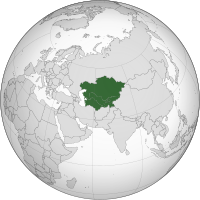Central Asian Republics
| Central Asia | |
|---|---|
 |
|
| Area | 4,003,451 km2 (1,545,741 sq mi) |
| Population | 67,986,864 |
| Density | 16.6/km2 (43/sq mi) |
| Countries |
Kazakhstan Kyrgyzstan Tajikistan Turkmenistan Uzbekistan |
| Regional Center | Kazakhstan |
| Nominal GDP (2012) | $295.331 billion |
| GDP per capita (2012) | $6,044 |
Central Asia or Middle Asia is the core region of the Asian continent and stretches from the Caspian Sea in the west to China in the east and from Afghanistan in the south to Russia in the north. It is also colloquially referred to as "the 'stans" (as the five countries generally considered to be within the region all have names ending with the Persian suffix "-stan", meaning "land of") and is within the scope of the wider Eurasian continent.
In modern contexts, all definitions of Central Asia include these five republics of the former Soviet Union: Kazakhstan (pop. 17 million), Kyrgyzstan (5.7 million), Tajikistan (8.0 million), Turkmenistan (5.2 million), and Uzbekistan (30 million), for a total population of about 66 million as of 2013–2014. Afghanistan (pop. 31.1 million) is also sometimes included.
Various definitions of Central Asia's exact composition exist, and not one definition is universally accepted. Despite this uncertainty in defining borders, the region does have some important overall characteristics. For one, Central Asia has historically been closely tied to its nomadic peoples and the Silk Road. As a result, it has acted as a crossroads for the movement of people, goods, and ideas between Europe, Western Asia, South Asia, and East Asia.
During pre-Islamic and early Islamic times, Central Asia was a predominantly Iranian region that included the sedentary Eastern Iranian-speaking Bactrians, Sogdians and Chorasmians, and the semi-nomadic Scythians and Parthians. The ancient sedentary population played an important role in the history of Central Asia. After expansion by Turkic peoples, Central Asia also became the homeland for many Turkic peoples, including the Kazakhs, Uzbeks, Turkmen, Kyrgyz, Uyghurs, and other extinct Turkic nations; Turkic languages largely replaced the Iranian languages spoken in the area. Central Asia is sometimes referred to as Turkestan.
...
Wikipedia
